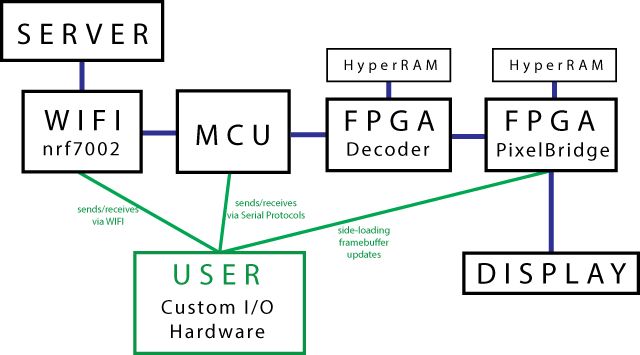A long-term plan for making Linux-display hardware more modular, open, and embedded-friendly.
What's Next
The project is evolving rapidly. Here are some highlights from the upcoming roadmap:
- Move decoding to a low-power FPGA (<20 ms/frame goal for decoding)
- Refine server program (encoder) and speed further up
- Support for multiple displays and resolutions
- Peer-to-peer networking mode without router
- Optional cellular connectivity for remote use
- Display bridging architecture with pluggable bitstreams
Context and Motivation
After creating the initial proof of concept (see Project page), I wasn’t fully satisfied with the outcome. While it’s usable for many things—sensor dashboards, web browsing, etc.—I want to push further: lower power consumption, higher speed, and more flexibility.
This isn’t just a display. I want to create a modular system where anyone can override pixels via sideloading over SPI or reroute raw parallel RGB output to alternative display interfaces. It’s a lightweight, hackable ecosystem of components that speak Linux—without needing to run Linux.
FPGA-Based Decoder and Display Bridge
Currently, I’m writing Verilog to synthesize my custom codec into a low-power FPGA from Lattice. It’s close to first test results. Simulations suggest up to 20 ms per frame at 720×720 RGB888 when clocked at 100 MHz.
The decoded RGB frame will be pushed to a display bridge FPGA. This bridge will eventually support multiple displays. The idea: load the right bitstream for your specific panel. I’ll release this code as open source so others can extend it—add their own display support, build routing examples (e.g. in KiCad), and more.

The bridge will also support pixel sideloading, allowing parts of the framebuffer to update independently of the Linux host. Use cases include:
- Touchscreen overlays that must function without a network
- Special system buttons rendered locally
- Video streams from dedicated decoders (e.g. AV1/H.265) where real-time playback isn’t needed
Wi-Fi and Peer-to-Peer Networking
The device uses the NRF7002 Wi-Fi chip, and peer-to-peer (P2P) mode is supported—so multiple devices can communicate directly without a router.
Future Plans and Hardware Iterations
I plan to release and sell hardware iterations for those interested or who want to support the project. The first version will include:
- 720×720 display
- Touchscreen support
- Wi-Fi as the only network interface
- FPGA-based decoder and display bridge
Some parts are already mature enough to share. These will be open source—letting you tweak, experiment, or extend as needed.
Target Audience
Many hobbyists and start-ups struggle with display integration. I believe this project can remove that barrier in the long run. If any of my explanations are unclear, feel free to ask questions—your feedback helps refine the concept.
Server-Side Improvements
I’m still deciding between three directions:
- Building custom encoding hardware
- Leveraging GPU parallelism
- Sticking with optimized CPU software encoding
For now, since my target resolution is capped at 720×720, I’ll continue using CPU-based encoding and focus on optimization via modern instruction sets. I’ll also test performance on lower-end devices like the Raspberry Pi to assess worst-case scenarios.
Cellular Connectivity
Once I’m satisfied with the FPGA-based approach, I plan to add SIM card support for optional cellular networking.
